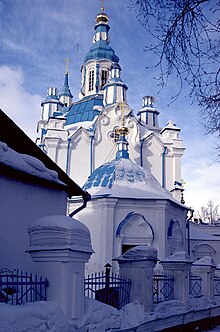
Back Sibiřské baroko Czech Barroco siberiano Spanish Style baroque sibérien French Sibearyske barok Frisian Сибирское барокко Russian Сибирски барок Serbian Сибірське бароко Ukrainian

Siberian Baroque is an architectural style common for ambitious structures in 18th-century Siberia, where 115 stone churches in Siberia were recorded in 1803, most of which were built in this provincial variant of the Russian Baroque, influenced by the Ukrainian Baroque and in some cases even incorporating lamaist motifs. Most of the buildings were preserved in Irkutsk, Tobolsk and Tomsk. An original interior of a Siberian Baroque structure survives only in the Feast of the Cross Church in Irkutsk.[1]
Siberian churches of the 18th century, like most of Russian[2] and Baroque buildings, are astylar.[1] The refectory and belfries are joined at the western side. Paintings in Siberian Baroque buildings are typically becoming smaller in its dimension (A. Yu. Kaptikov called this technique the "Baroque advanced form").[3] Decorativelly it features foreign exotic motifs, likely of eastern origin (examples are arrow-shaped and "flaming" cornices, stupa-like forms and dharmacakras).[4]
- ^ a b Cite error: The named reference
mswas invoked but never defined (see the help page). - ^ an architectural style of the 17th century in the Russian Tsardom, characterically for its inventive forms, abundant decor, difficult composition and artificial silhouettes
- ^ A. Yu. Kaptikov, Региональное многообразие архитектуры русского барокко (Regional diversity of the architecture of Russian Baroque)]. MARKHI, 1986, pp. 31, 59.
- ^ Cite error: The named reference
brumfieldwas invoked but never defined (see the help page).
© MMXXIII Rich X Search. We shall prevail. All rights reserved. Rich X Search